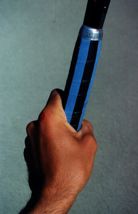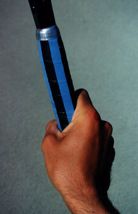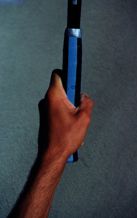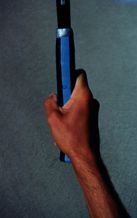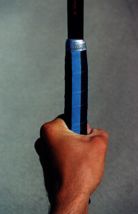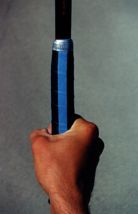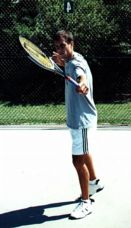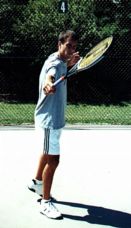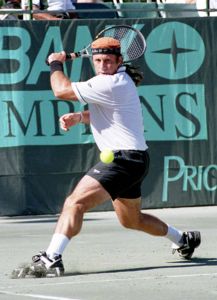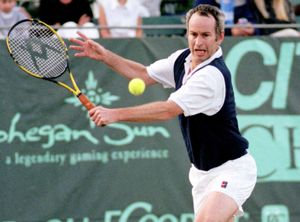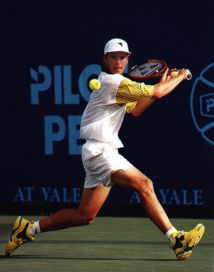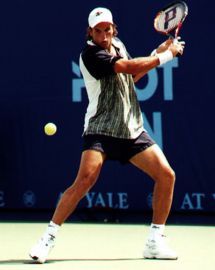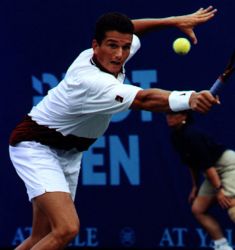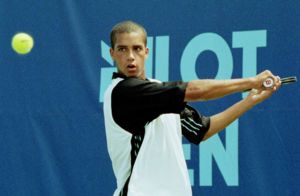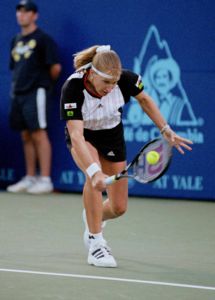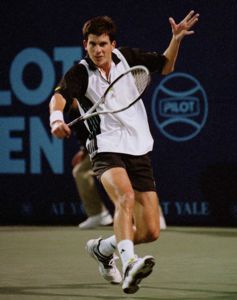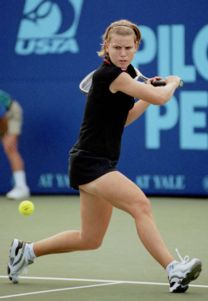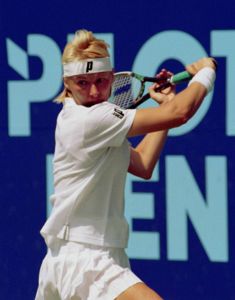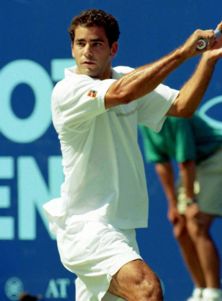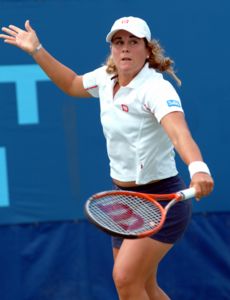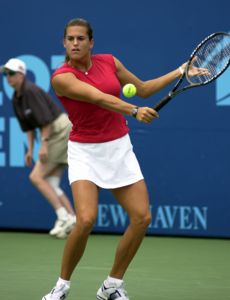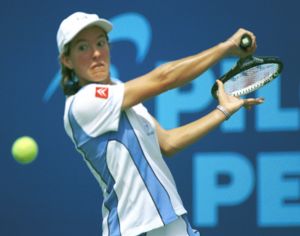September 2003 Article Turbo Tennis Archives:
Tennis Server
|

 |
to the Backhand: The One-Handed Slice
Last month, we addressed the two-handed backhand, which I believe to be the most commonly used backhand in the modern game. Although I believe this particular stroke is powerful, fairly easy to learn and a bit more forgiving in some ways, it cannot and should not be a player’s only backhand. It is my firm belief that every player needs to have a one-handed slice backhand in her/his repertoire. Invariably, the reader will ask the question: Why? Well, the first reason is that the two-handed backhand is limited with respect to reach. When really stretched out, a player cannot hope to put a racquet on the ball with a two fisted stroke. Sooner or later, every player is forced to hit a backhand with only one hand on the grip. The slice is the defensive shot that most players will opt for in these situations. If nothing else, the player can use the high, defensive, sliced lob in emergency situations. In fact, this should probably be your first choice in most emergency situations involving the backhand wing. Second, the one-handed slice imparts a spin that allows for a player to change the tenor of a rally. In long rallies, especially on the club level, adding some slice to a shot may be enough to change the rhythm of the opponent’s rally enough to force an error. This is particularly true if the opponent uses a western forehand grip. Third, the one-handed slice allows for easily produced "blocked" returns. If you saw many of the matches at the 2003 Championships held at Wimbledon, you probably noticed that many times the best a receiver could do was to block back a serve. When hit to the backhand wing, the one-handed slice is a shot that lends itself to a controlled, blocked return. Finally, the one-handed slice is an excellent shot to use when approaching the net. This is particularly true when one slices deeply down the line, or at a very acute angle crosscourt. Now, I know that some of my readers never come to the net, except to shake hands, but a wise opponent will sense this. The opponent will force the player to come to the net. How? By hitting short balls that usually are struck with lots of slice. Having a one-handed slice in your arsenal of shots makes it easier to get to these short shots, and to hit a reply that will force a higher shot from the opponent. These higher balls are much easier to volley. So, in my mind, every two-handed player should develop a strong and potentially offensive one-handed slice backhand. These slice shots can be particularly offensive when playing on faster surfaces like found on grass courts or indoors. The major disadvantages to the one-handed slice involve "floating" the shot. By this, I mean that the slice is hit without much drive and passes high over the net. These floaters, if hit without a specific purpose, become fair game for the seasoned player who likes to come in and volley. On windy days, the one-handed slice can be a problem. If there is no "weight" to the stroke, the ball is very easily hit deep, wide or into the net. On windy days, I like to slice hard and low to the net when the wind is to my back. I do not slice at all when the wind is in my face. Crosswinds or winds that swirl and change direction are usually bad times to use slice for anything other than an approach shot. I am not alone in my thinking about the importance of the one-handed slice. Mats Wilander improved significantly after adding this stroke to his game. In fact, his preparation for both this two-handed backhand and his one-handed, sliced backhand were remarkably similar. This added an element of deception to his game. So, let’s begin a discussion of the one-handed slice from an Integrated point of view. As always, we will begin with our grip. One-handed slice backhands can be hit with three different grips: the eastern backhand grip, the continental grip/hammer grip, and even with the eastern forehand grip. I do not recommend the latter, in that this forehand grip will usually result in floaters…particularly if the ball is struck with the racquet away from your body. Here are the recommended grips for this stroke. Please note that the blue areas of the racquet handle represent the top, bottom and sides. The black areas are the bevels. The eastern backhand grip: This is the continental grip: This grip is the hammer grip, which is really a closed fisted continental grip: All of these grips can be used effectively to hit the one-handed slice. For most players, I believe the continental and/or hammer grip will be the easiest and most comfortable. The eastern backhand grip does, however, permit the player to hit a very driving slice. In my game, I use all of these grips. If I have time to setup, I use the eastern backhand grip and try to hit a very "biting" slice. If I am on the run, or hitting defensively, I will use the continental grip. For reasons that I have yet to understand, I find the hammer grip very useful when I want to hit a drop shot. Most of my students, when encouraged to experiment with grips when hitting the one-handed backhand slice, will opt for the continental in almost all situations. This grip is favored by most of the "legend" players of the past, and is remarkably flexible when hitting slice. Regardless of grip, the one-handed, backhand slice is best hit from a closed stance…even when you are on the run. Open stances usually result in shots that are floaters. Closed stances put you sideways to the net. The only exception to this, in my experience, is when one hits the drop shot off the backhand wing. In this situation, a slightly open stance will usually make for a nice, short "dropper." The contact point for the one-handed, backhand slice is generally best when the ball reaches your forward shoulder, and when hit a bit closer to your body. Hitting the ball too far in front of your body will create a weak and/or floating shot. Hitting the ball too late will result in a shot with lots of sidespin that usually travels wide. If you are hitting defensively, the ball that is struck farther away from your body will lend itself to the backspin lob. Believe me, this particular shot has kept me in many points. When striking the one-handed, backhand slice, it is key to keep the body weight moving or leaning forward. Once you put the weight on the back foot or lean back as you strike this shot, you are likely to hit a floater. The proper finish for the one-handed slice is to have the racquet in front of your body. Do not allow the racquet to cross your body. If you do, you will be imparting more sidespin, and frequently, the shot will be a floater. Here is the proper finish for the one-handed, backhand slice: Here are some shots of players on the tours, executing the one-handed, backhand slice: I have included a lot of images of this shot, because it is one that virtually every pro owns. You will note the high to low motion of the racquet in these images. Note the closed or nearly closed stances. Note that the ball can be hit close or farther away from the body, but almost always it is hit at the front shoulder area. Except when a player is on the run, she/he almost always has her/his weight going forward at the moment of impact. If she/he does not, you can be sure that the ball was hit with a high trajectory. The one-handed, backhand slice is really a fairly easy shot to hit. It usually feels fairly natural to move the racquet in this downward "chopping" or "slicing" manner. However, in my opinion, this shot is not an option. Instead it is a requisite to playing effective tennis. I see so many juniors who don’t work enough on this particular stroke. They will rarely practice it, and hit it only when absolutely necessary. Although this shot is an "old school" shot, it has a permanent place in the modern game. If you work on the one-handed, backhand slice and include it in your game; I am sure that you will soon become a tennis overdog!
1996 - 2002 | 2003 - Present
This column
is copyrighted by Ron Waite, all rights reserved. Questions and comments
about these columns can be directed to Ron by using this form.
Ron Waite is a certified USPTR tennis instructor who took up the game
of tennis at the age of 39. Frustrated with conventional tennis methods
of instruction and the confusing data available on how to learn the
game, Ron has sought to sift fact from fiction. In his seven years of
tennis, Ron has received USTA sectional ranking four years, has successfully
coached several NCAA Division III men's and women's tennis teams to
post season competition, and has competed in USTA National singles tournaments.
Ron has trained at a number of tennis academies and with many of the
game's leading instructors.
In addition to his full-time work as a professor at Albertus Magnus
College, Ron photographs ATP tour events for a variety of organizations
and publications. The name of his column, TurboTennis, stems from his
methods to decrease the amount of time it takes to learn and master
the game of tennis.
|



October 2022 Tennis Anyone: Patterns in Doubles by John Mills. September 2022 Tennis Anyone: Short Court by John Mills. |
 You will join 13,000 other subscribers in receiving news of updates to the Tennis Server along with monthly tennis tips from tennis pro Tom Veneziano.
You will join 13,000 other subscribers in receiving news of updates to the Tennis Server along with monthly tennis tips from tennis pro Tom Veneziano. 
